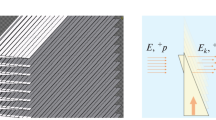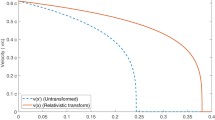Abstract
The well-known Bragg-Kleeman rule R CSDA = A ⋅ E has become a pioneer work in radiation physics of charged particles and is still a useful tool to estimate the range R CSDA of approximately monoenergetic protons with initial energy E 0 in a homogeneous medium. The rule is based on the continuous-slowing-down-approximation (CSDA). It results from a generalized (nonrelativistic) Langevin equation and a modification of the phenomenological friction term. The complete integration of this equation provides information about the residual energy E(z) and dE(z)/dz at each position z(0 ≦ z ≦ R CSDA). A relativistic extension of the generalized Langevin equation yields the formula R CSDA = A ⋅ (E 0 + E/2M ⋅ c 2)p. The initial energy of therapeutic protons satisfies E 0 ≪ 2M ⋅ c 2(M ⋅ c 2 = 938.276 MeV), which enables us to consider the relativistic contributions as correction terms. Besides this phenomenological starting-point, a complete integration of the Bethe-Bloch equation (BBE) is developed, which also provides the determination of R CSDA, E(z) and dE(z)/dz and uses only those parameters given by the BBE itself (i.e., without further empirical parameters like modification of friction). The results obtained in the context of the aforementioned methods are compared with Monte-Carlo calculations (GEANT4); this Monte-Carlo code is also used with regard to further topics such as lateral scatter, nuclear interactions, and buildup effects. In the framework of the CSDA, the energy transfer from protons to environmental atomic electrons does not account for local fluctuations. Based on statistical quantum mechanics, an analysis of the Gaussian convolution and the Landau-Vavilov distribution function is carried out to describe these fluctuations. The Landau tail is derived as Hermite polynomial corrections of a Gaussian convolution. It is experimentally confirmed that proton Bragg curves with E 0 ≧ 120 MeV show a buildup, which increases with the proton energy. This buildup is explained by a theoretical analysis of impinging proton beamlets. In order to obtain a complete dose calculation model for proton treatment planning, some further aspects have to be accounted for: the decrease of the fluence of the primary protons due to nuclear interactions, the transport of released secondary protons, the dose contribution of heavy recoil nuclei, the inclusion of lateral scatter of the primary and secondary protons based on Molière’s multiple-scatter theory, and the scatter contributions of collimators. This study also presents some results which go beyond proton dose calculation models; namely, the application of the relativistic generalization of the Bragg-Kleeman rule to electrons and, in an appendix, a method to determine inelastic cross-sections of therapeutic protons in media of therapeutic interest.
Similar content being viewed by others
References
M. Abramowitz, I. Stegun, Handbook of Mathematical Functions with Formulas, Graphs, Mathematical Tables Natural Bureau of Standards, 1970
J.C. Ashley, R.H. Ritchie, W. Brandt, Document No. 021195, (National Auxilliary Service, New York, 1974)
M.J. Berger, J.S Coursey, M.A. Zucker, ESTAR, PSTAR, ASTAR: Computer Programs for calculating Stopping-Power and Range Tables for Electrons, Protons and α-particles (version 1.2.2) National Institute of Standards and Technology, Gaithersburg, MD, 2000
M.J. Berger, Proton Monte Carlo transport program PTRAN National Institute of Standards, Technology, Report NISTIR-5113, 1993
H.A. Bethe, Ann. Physik 5, 325 (1930)
H.A. Bethe, Phys. Rev. 89, 1256 (1953)
F. Bloch, Ann. Physik 16, 285 (1933)
S.N. Boon, Ph.D thesis Rijks University Groningen, 1998
T. Bortfeld, Med. Phys. 24, 2024 (1997)
G. Ciangaru, J. Polf, M. Bues, A. Smith, Med. Phys. 32, 3511 (2005)
M.B. Chadwick, P.G. Young, Los Alamos National Laboratory Report LAUR-96-1649, 1996
J.O. Deasy, Med. Phys. 25, 476 (1998)
J.P. Elliott, The Nuclear Shell Theory and its relation with other models, (Wien, International Atomic Energy Agency, 1963)
R.D. Evans, Atomic Nucleus, (Robert E. Krieger, Malabar, FL, 1982) (1962)
L. Eyges, Phys. Rev. 74, 1434 (1948)
R.P. Feynman, Quantum electrodynamics - Lecture Notes and Reprints, (Benjamin, New York, 1962)
R.P. Feynman, A.R. Hibbs, Quantum mechanics and path integrals, (Mac Graw Hill, New York, 1965)
R.P. Feynman, Photon-Hadron-Interaction, (Benjamin, New York, 1972)
M. Fippel, M. Soukup, Med. Phys. 31, 2263 (2004)
S.Z. Flügge, Naturforschung 3a, 97 (1948)
GEANT4 Documents 2005; available from the internet address: http://geant4.web.cern/geant4/G4UsersDocuments/Overview/html/
B. Gottschalk, A.M. Koehler, R.J. Schneider, J.M. Sisterson, M.S. Wagner, Nucl. Instr. Meth. 74, 467 (1993)
B. Gottschalk, R. Platais, H. Platais, Med. Phys. 26, 2597 (1999)
W. Heisenberg, Z. Physik 96, 473 (1935)
V.L. Highland, Nucl. Instr. Meth. 129, 497 (1975)
M. Hollmark, J. Uhrdin, D. Belkic, I. Gudowska, A. Brahme, Phys. Med. Biol. 49, 3247 (2004)
L. Hong, M. Goitein, M. Bucciolini, R. Comiskey, B. Gottschalk, S. Rosenthal, C. Serago, M. Urie, Phys. Med. Biol. 41, 1305 (1996)
ICRU, Stopping powers, ranges for protons and α-particles ICRU Report 49 (Bethesda, MD, 1993)
J.F. Janni, Atom. Data Nucl. Data Tables 27, 147 (1982)
H. Jiang, H. Paganetti, Med. Phys. 31, 2811 (2004)
E. Matsinos, available from the internet address: http://arxiv.org/abs/0811.1076 (2008)
T. Matsuura, S. Saitoh, Appl. Anal. 85, 901 (2006)
J. Medin, P. Andreo, Phys. Med. Biol. 42, 89 (1997)
M. Meyer-Goeppert, J. Jensen, Nuclear Shell Theory, (Wiley, New York, 1970)
R.G. Milner, Nucl. Phys. A588, 599C (1990)
G. Molière, Z. Naturforschung 10a, 177 (1955)
K. O’Brien, The physics of radiation transport Computer Techniques in Radiation Transport and Dosimetry, edited by W.R. Nelson and T.M. Jenkins (Plenum Press, New York and London, 1979)
H. Paganetti, Phys. Med. Biol. 47, 747 (2002)
P. Pedroni, S. Scheib, T. Böhringer, A. Coray, M. Grossmann, S. Lin, A. Lomax, Phys. Med. Biol. 50, 541 (2005)
P. Petti, Int. J. Rad. Oncol. Biol. Phys. 35, 1049 (1996)
M.R. Rahu, Heavy Particle Radiotherapy, (Academic Press, New York, 1980)
K.R. Russel, U. Isacson, M. Saxner, A. Ahnesjö, A. Montelius, E. Grusell, C. Dahlgren, S. Lorin, B. Glimelius, Phys. Med. Biol. 45, 9 (2000)
S. Saitoh, Commun. Korean Math. Society 371 (2001)
G. Sandison, C. Lee, X. Lu, L. Papiez, Med. Phys. 24, 841 (1997)
B. Schaffner, E. Pedroni, A. Lomax, Phys. Med. Biol. 44, 27 (1999)
B. Schaffner, Phys. Med. Biol. 53, 1545 (2008)
U. Schneider, E. Pedroni, A. Lomax, Phys. Med. Biol. 41, 111 (1996)
E. Segrè, Nuclei and Particles, (Benjamin, New York, 1964)
H. Szymanowski, U. Oelfke, Phys. Med. Biol. 47, 3313 (2002)
A. Tourovsky, A. Lomax, U. Schneider, E. Pedroni, Phys. Med. Biol. 50, 971 (2005)
W. Ulmer, Inv. Probl. 26, 085002 (2010)
W. Ulmer, Rad. Phys. Chem. 76, 1089 (2007)
W. Ulmer, W. Kaissl, Phys. Med. Biol. 48, 707 (2003)
W. Ulmer, J. Pyyry, W. Kaissl, Phys. Med. Biol. 50, 1767 (2005)
W. Ulmer, B. Schaffner, IFMBE Proceedings 2125, (Springer Publishing, Berlin – Heidelberg – New York, 2006)
W. Ulmer, Theor. Chim. Acta 55, 179 (1980)
W. Ulmer, Nuovo Cimento 51A, 309 (1979)
W. Ulmer, H. Hartmann, Nuovo Cimento 47A, 59 (1978)
W. Ulmer, H. Hartmann, Nuovo Cimento 47A, 359 (1978)
C.D. Zerby, W.E. Kinney, Nucl. Instr. Meth. 36, 125 (1965)
R. Zhang, D. Newhauser, Phys. Med. Biol. 54, 1383 (2009)
Author information
Authors and Affiliations
Corresponding author
Rights and permissions
About this article
Cite this article
Ulmer, W., Matsinos, E. Theoretical methods for the calculation of Bragg curves and 3D distributions of proton beams. Eur. Phys. J. Spec. Top. 190, 1–81 (2010). https://doi.org/10.1140/epjst/e2010-01335-7
Received:
Revised:
Published:
Issue Date:
DOI: https://doi.org/10.1140/epjst/e2010-01335-7




